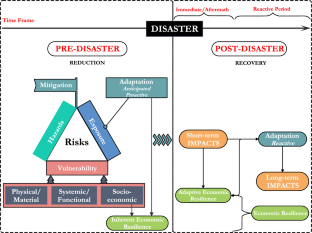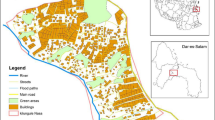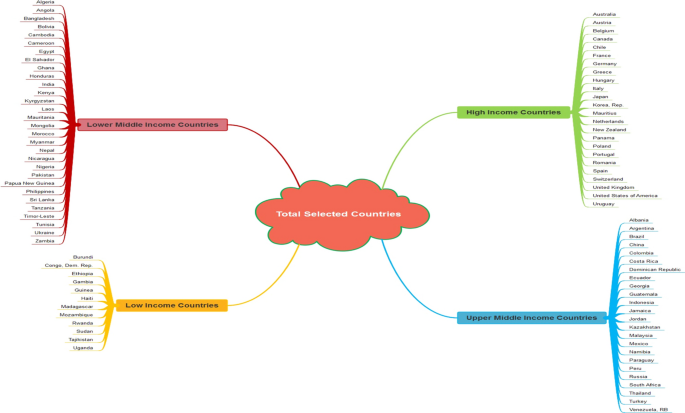Abstract
Reducing natural disasters and their related economic losses remains critical to achieving sustainable development. However, there is a lack of comprehensive studies that assess sustainable cities and human settlements in efforts to attain sustainable development goal 11.5. Here, the present research explains the effect of disaster risk and disaster resilience on human loss due to natural disasters (deaths, injured, and affected) in 90 countries spanning 1995 to 2019. We develop global risk and resilience indices through IMF index-making steps across 24 high, 24 upper-middle, 30 lower-middle, and 12 low-income countries. The negative binomial regression shows an increase in disaster-related loss to human beings (deaths, injured, and affected) due to disaster risk in all panels. The empirical results reveal a favorable impact of disaster resilience––resilience declines disaster-related losses in developed countries. We observe that focusing on basic infrastructure, economic stability, public awareness, hygiene practices, ICT, and effective institutions leads to disaster resilience, mitigation, and speedy post-disaster recovery. Due to the insignificant impact of resilience in developing countries, high-income countries could provide financial resources, modern and DRR technologies, especially to low-income economies. This study encourages countries to follow seven targets and four dimensions of the Sendai Framework to enhance disaster resilience.















Similar content being viewed by others
Availability of data and material
Data will be available upon request.
References
Aghapour AH, Yazdani M, Jolai F, Mojtahedi M (2019) Capacity planning and reconfiguration for disaster-resilient health infrastructure. J Build Eng 26:100853. https://doi.org/10.1016/j.jobe.2019.100853
Ahmed J, Jaman MH, Saha G, Ghosh P (2021) Effect of environmental and socio economic factors on the spreading of COVID-19 at 70 cities/provinces. Heliyon 7:e06979. https://doi.org/10.1016/j.heliyon.2021.e06979
Alam K, Rahman MH (2017) Chapter 29: the role of women in disaster resilience. In: Madu CN, Kuel C (eds) Handbook of disaster risk reduction & management. World Scientific Publishing, Singapore. https://doi.org/10.1142/9789813207950_0029
Albuquerque PH, Rajhi W (2019) Banking stability, natural disasters, and state fragility: panel VAR evidence from developing countries. Res Int Bus Finance 50:430–443. https://doi.org/10.1016/j.ribaf.2019.06.001
Ali Q, Yaseen MR, Anwar S, Makhdum MSA, Khan MTI (2021) The impact of tourism, renewable energy, and economic growth on ecological footprint and natural resources: A panel data analysis. Resour Policy 74:102365
Al-Maruf A (2017) Enhancing disaster resilience through human capital: Prospects for adaptation to cyclones in coastal Bangladesh. University of Cologne, Germany
Arouri M, Nguyen C, Youssef AB (2015) Natural disasters, household welfare, and resilience: evidence from rural Vietnam. World Dev 70:59–77. https://doi.org/10.1016/j.worlddev.2014.12.017
Asadzadeha A, Köttera T, Salehib P, Birkmann J (2017) Operationalizing a concept: The systematic review of composite indicator building for measuring community disaster resilience. Int J Disaster Risk Reduct 25:147–162. https://doi.org/10.1016/j.ijdrr.2017.09.015
Ashmawy IKIM (2020) Stakeholder involvement in community resilience: evidence from Egypt. Environ Dev Sustain 23:7996–8011. https://doi.org/10.1007/s10668-020-00894-9
Balaei B, Noy I, Wilkinson S, Potangaroa R (2021) Economic factors affecting water supply resilience to disasters. Socio-Econ Plan Sci 76:100961. https://doi.org/10.1016/j.seps.2020.100961
Benali N, Abdelkafi I, Feki R (2018) Natural-disaster shocks and government’s behavior: evidence from middle income countries. Int J Disaster Risk Reduct 27:1–6. https://doi.org/10.1016/j.ijdrr.2016.12.014
Birkmann J (2006) Measuring vulnerability to promote disaster-resilient societies: conceptual frameworks and definitions, In: Measuring vulnerability to natural hazards: towards disaster resilient societies; United Nations University: New York, NY, USA
Bonnet J, Coll-Martínez E, Renou-Maissant P (2021) Evaluating sustainable development by composite index: evidence from French departments. Sustainability 13:761. https://doi.org/10.3390/su13020761
Cavallo A, Ireland V (2014) Preparing for complex interdependent risks: a system of systems approach to building disaster resilience. Int J Disaster Risk Reduct 9:181–193. https://doi.org/10.1016/j.ijdrr.2014.05.001
Centre for research on the epidemiology of disasters (CRED) (2021) EM-DAT The international disaster database. Institute health and society UClouvain, Belgium, www.emdat.be, Accessed 01 April 2021
Chok NS (2008) Pearson’s versus Spearman’s and Kendall’s correlation coefficients for continuous data. M.Sc. thesis, University of Pittsburgh, Pennsylvania, the United States
Chowdhury JR, Parida Y, Goel PA (2021) Does inequality-adjusted human development reduce the impact of natural disasters? A gendered perspective. World Dev 141:105394. https://doi.org/10.1016/j.worlddev.2021.105394
Chun H, Chi S, Hwang B (2017) A spatial disaster assessment model of social resilience based on geographically weighted regression. Sustainability 9:2222. https://doi.org/10.3390/su9122222
Cimellaro GP, Reinhorn AM, Bruneau M (2011) Performance-based metamodel for healthcare facilities. Earthq Eng Struct Dyn 40:1197–1217. https://doi.org/10.1002/eqe.1084
Cimellaro GP, Tinebra A, Renschler C, Fragiadakis M (2016) New resilience index for urban water distribution networks. J Struct Eng 142:C4015014. https://doi.org/10.1061/(ASCE)ST.1943-541X.0001433
Davies TRH, Davies AJ (2018) Increasing communities’ resilience to disasters; an impact-based approach. Int J Disaster Risk Reduct 31:742–749. https://doi.org/10.1016/j.ijdrr.2018.07.026
Dayton-Johnson J (2006) Natural disaster and vulnerability. OECD Publishing. https://doi.org/10.1787/202670544086
Eisensee T, Stromberg D (2007) News droughts, news floods, and US disaster relief. Q J Econ 122:693–728
Firdhous MFM, Karuratane PM (2018) A model for enhancing the role of information and communication technologies for improving the resilience of rural communities to disasters. Procedia Eng 212:707–714. https://doi.org/10.1016/j.proeng.2018.01.091
Fischer S (2021) Post-disaster spillovers: Evidence from Iranian provinces. J Risk Financ Manag 14:193. https://doi.org/10.3390/jrfm14050193
French EL, Birchall SJ, Landman K, Brown RD (2019) Designing public open space to support seismic resilience: a systematic review. Int J Disaster Risk Reduct 34:1–10. https://doi.org/10.1016/j.ijdrr.2018.11.001
Gaiha R, Hill K, Thapa G (2010) Natural disasters in South Asia. ASARC Working Paper 2010/06, Australia South Asia research centre. The Australian National University, Australia
Gaillard J (2010) Vulnerability, capacity and resilience: perspectives for climate and development policy. J Int Dev 22:218–232. https://doi.org/10.1002/jid.1675
Global state of democracy (GSD) (2021) World Bank, https://govdata360.worldbank.org/, Accessed 01 Aug 2021
Graveline N, Grémont M (2017) Measuring and understanding the microeconomic resilience of businesses to lifeline service interruptions due to natural disasters. Int J Disaster Risk Reduct 24:526–538. https://doi.org/10.1016/j.ijdrr.2017.05.012
Guha-Sapir D, Vos F, Below R, Ponserre S (2012) Annual disaster statistical review 2011: the numbers and trends. Brussels: C.R.E.D. Retrieved from www.cred.be/sites/default/files/ADSR_2011.pdf
Habiba U, Abedin MA, Shaw R (2016) Chapter 6: Food security, climate change adaptation, and disaster risk. In: Uitto JI, Shaw R (eds) Sustainable development and disaster risk reduction. Disaster risk reduction, Springer, Tokyo. https://doi.org/10.1007/978-4-431-55078-5_1
Haen HD, Hemrich G (2007) The economics of natural disasters: implications and challenges for food security. Agri Econ 37:31–45. https://doi.org/10.1111/j.1574-0862.2007.00233.x
Haque CE (2003) Perspectives of natural disaster in East and South Asia, and the Pacific Island states: socioeconomic correlates and need assessment. Nat Hazards 29:465–483. https://doi.org/10.1023/A:1024765608135
Havko J, Mitašová V, Pavlenko T, Titko M, Kováčová J (2017) Financing the disaster resilient city in the Slovak Republic. Procedia Eng 192:301–306. https://doi.org/10.1016/j.proeng.2017.06.052
Holling CS (1973) Resilience and stability of ecological systems. Annu Rev Ecol Syst 4:1–23. https://doi.org/10.1146/annurev.es.04.110173.000245
Husted T, Nickerson D (2021) Private support for public disaster aid. J Risk Financ Manag 14:247. https://doi.org/10.3390/jrfm14060247
Notre Dame Global Adaptation Initiative (ND-GAIN) (2021) University of Notre Dame, https://gain.nd.edu/, Accessed 01 Aug 2021
International Monetary Fund (IMF) (2021) International Monetary Fund, http://data.imf.org/?sk=F8032E80-B36C-43B1-AC26-493C5B1CD33B, Accessed 01 Aug 2021
Kahn ME (2005) The death toll from natural disasters: the role of income, geography and institutions. Rev Econ Stat 87:271–284
Khan MTI, Anwar S, Batool Z (2022) The role of infrastructure, socio-economic development, and food security to mitigate the loss of natural disasters. Environ Sci Pollut Res 29:52412–52437. https://doi.org/10.1007/s11356-022-19293-w
Kontokosta CE, Malik A (2018) The resilience to emergencies and disasters index: applying big data to benchmark and validate neighborhood resilience capacity. Sustain Cities Soc 36:272–285. https://doi.org/10.1016/j.scs.2017.10.025
Ludin SM, Rohaizat M, Arbon P (2019) The association between social cohesion and community disaster resilience: a cross-sectional study. Health Soc Care Community 27(3):621–631. https://doi.org/10.1111/hsc.12674
McDaniels T, Chang S, Hawkins D, Chew G, Longstaff H (2015) Towards disaster- resilient cities: an approach for setting priorities in infrastructure mitigation efforts. Environ Syst Decis 35:252–263. https://doi.org/10.1007/s10669-015-9544-7
Moreno J, Shaw D (2018) Women’s empowerment following disaster: a longitudinal study of social change. Nat Hazards 92:205–224. https://doi.org/10.1007/s11069-018-3204-4
Naudé WA, Bezuidenhout H (2014) Migrant remittances provide resilience against disasters in Africa. Atl Econ J 42:79–90. https://doi.org/10.1007/s11293-014-9403-9
Noy I (2009) The macroeconomic consequences of disasters. J Dev Econ 88:221–231. https://doi.org/10.1016/j.jdeveco.2008.02.005
Noy I, Yonson R (2018) Economic vulnerability and resilience to natural hazards: a survey of concepts and measurements. Sustainability 10:2850. https://doi.org/10.3390/su10082850
Oztig LI, Askin OE (2020) Human mobility and coronavirus disease 2019 (COVID-19): a negative binomial regression analysis. Public Health 185:364–367.
Padli J, Habibullah MS (2009) Natural disaster and socio-economic factors in selected Asian countries: A panel analysis. Asian Soc Sci 5:65–71. https://doi.org/10.5539/ass.v5n4p65
Padli J, Habibullah MS, Baharom AH (2010) Economic impact of natural disasters’ fatalities. Int J Soc Econ 37:429–441. https://doi.org/10.1108/03068291011042319
Padli J, Habibullah MS, Baharom AH (2018) The impact of human development on natural disaster fatalities and damage: panel data evidence. Econ Res 31:1557–1573. https://doi.org/10.1080/1331677X.2018.1504689
Panwar V, Sen S (2019) Economic impact of natural disasters: An empirical re-examination. Margin J Appl Econ Res 13:109–139. https://doi.org/10.1177/0973801018800087
Persson TA, Povitkina M (2017) “Gimme Shelter”: The role of democracy and institutional quality in disaster preparedness. Political Res Q. https://doi.org/10.1177/1065912917716335
Pingali P, Alinovi L, Sutton J (2005) Food security in complex emergencies: enhancing food system resilience. Disasters 29:S5–S24. https://doi.org/10.1111/j.0361-3666.2005.00282.x
Qin Y, Shi X, Li X, Yan J (2021) Geographical indication agricultural products, livelihood capital, and resilience to meteorological disasters: evidence from kiwifruit farmers in China. Environ Sci Pollut Res 28:65832–65847. https://doi.org/10.1007/s11356-021-15547-1
Qureshi MI, Yusoff RM, Hishan SS, Alam ASAF, Zaman K, Rasli AM (2019) Natural disasters and Malaysian economic growth: policy reforms for disasters management. Environ Sci Pollut Res 26:15496–15509. https://doi.org/10.1007/s11356-019-04866-z
Rahman MH (2018) Earthquakes don’t kill, built environment does: Evidence from cross country data. Econ Model 70:458–468. https://doi.org/10.1016/j.econmod.2017.08.027
Raschky PA (2008) Institution and the losses from natural disasters. Nat Hazards Earth Syst Sci 8:627–634. https://doi.org/10.5194/nhess-8-627-2008
Rose A (2004) Defining and measuring economic resilience to disasters. Disaster Prev Manag 13:307–314. https://doi.org/10.1108/09653560410556528
Sarker MNI, Peng Y, Yiran C, Shouse RC (2020) Disaster resilience through big data: Way to environmental sustainability. Int J Disaster Risk Reduct 51:101769. https://doi.org/10.1016/j.ijdrr.2020.101769
Shah AA, Shaw R, Ye J, Abid M, Amir SM, Pervez AKMK, Naz N (2019) Current capacities, preparedness and needs of local institutions in dealing with disaster risk reduction in Khyber Pakhtunkhwa, Pakistan. Int J Disaster Risk Reduct 34:165–172. https://doi.org/10.1016/j.ijdrr.2018.11.014
Shi Y, Sun J (2021) The influence of neighboring jurisdictions matters: examining the impact of natural disasters on local government fiscal accounts. Public Finance Rev 49:435–463. https://doi.org/10.1177/10911421211025740
Songwathana K (2018) The relationship between natural disaster and economic development: a panel data analysis. Procedia Eng 212:1068–1074. https://doi.org/10.1016/j.proeng.2018.01.138
Story WT, Tura H, Rubin J, Engidawork B, Ahmed A, Jundi F, Iddosa T, Abrha TH (2018) Social capital and disaster preparedness in Oromia, Ethiopia: an evaluation of the “women empowered” approach. Soc Sci Med 257:111907. https://doi.org/10.1016/j.socscimed.2018.08.027
Sun Y, Chau PH, Wong M, Woo J (2017) Place- and age-responsive disaster risk reduction for Hong Kong: collaborative place audit and social vulnerability index for elders. Int J Disaster Risk Sci 8:121–133. https://doi.org/10.1007/s13753-017-0128-7
Svirydzenka K (2016) Introducing a new broad-based index of financial development. IMF Working Paper No. WP/16/5. Strategy, policy, and review department, Washington, D.C., the United States
Swathi JM, González MA, Delgado RC (2017) Disaster management and primary health care: implications for medical education. Int J Med Educ 8:414–415. https://doi.org/10.5116/ijme.5a07.1e1b
Taghizadeh-Hesary F, Sarker T, Yoshino N, Mortha A, Vo XV (2021) Quality infrastructure and natural disaster resiliency: a panel analysis of Asia and the Pacific. Econ Anal Policy 69:394–406. https://doi.org/10.1016/j.eap.2020.12.021
Taghizadeh-Hesary F, Yoshino N, Mortha A, Sarker T (2019) Quality infrastructure and natural disaster resiliency. ADBI Working Paper Series No. 991. Asian development bank institute, Japan. https://www.adb.org/publications/quality-infrastructure-and-natural-disaster-resiliency
Tammar A, Abosuliman SS, Rahaman KR (2020) Social capital and disaster resilience nexus: A study of flash flood recovery in Jeddah city. Sustainability 12:4668. https://doi.org/10.3390/su12114668
Tanesab JP (2020) Institutional effectiveness and inclusions: Public perceptions on Indonesia’s disaster management authorities. Int J Disaster Manag 3:1–15. https://doi.org/10.24815/ijdm.v3i2.17621
Tarhan C, Aydin C, Tecim V (2016) How can be disaster resilience built with using sustainable development? Procedia-Soc Behav Sci 216:452–459. https://doi.org/10.1016/j.sbspro.2015.12.059
The climate change knowledge portal (TCCKP) (2021) The World Bank Group, https://climateknowledgeportal.worldbank.org/download-data, Accessed 15 May 2021
The United Nations office for disaster risk reduction (UNDRR) (2021) Sendai framework for disaster risk reduction 2015–2030. The disaster information management system (DesInventar), https://www.desinventar.net/index.html, Accessed 01 Apr 2021
The United Nations office for disaster risk reduction (UNISDR) (2019) global assessment report on disaster risk reduction 2019. 9–11 Rue de Varembé, CH 1202, Geneva, Switzerland, https://gar.unisdr.org
The World Bank and The United Nations (2010) Natural hazards, unnatural disasters: The economics of effective prevention. The World Bank, Washington DC
Thywissen K (2006) Core terminology of disaster reduction. In Measuring vulnerability to natural hazards: towards disaster resilient societies; Birkmann J (Ed.), United Nations University: New York, NY, USA
Toya H, Skidmore M (2007) Economic development and the impact of natural disasters. Econ Lett 94:20–25. https://doi.org/10.1016/j.econlet.2006.06.020
Tselios V, Tompkins E (2017) Local government, political decentralisation and resilience to natural hazard-associated disasters. Environ Hazards 16:228–252. https://doi.org/10.1080/17477891.2016.1277967
United Nations International Strategy for Disaster Reduction (UNISDR) (2004) Terminology: Basic Terms of Disaster Risk Reduction. UNISDR, Geneva
Weerasekara S, Wilson C, Lee B, Hoang V-N, Managi S, Rajapaksa D (2021) The impacts of climate induced disasters on the economy: Winners and losers in Sri Lanka. Ecol Econ 185:107043. https://doi.org/10.1016/j.ecolecon.2021.107043
World development indicators (WDI) (2021) World Bank. http://databank.worldbank.org, Accessed 01 Apr 2021
World governance indicators (WGI) (2021) World Bank, https://info.worldbank.org/governance/wgi/Home/Reports, Accessed 20 Mar 2021
World inequality database (WID) (2021) World inequality lab. https://wid.world/data/, Accessed 15 July 2021
Yun SD, Kim A (2021) Economic impact of natural disasters: a myth or mismeasurement? Appl Econ Lett. https://doi.org/10.1080/13504851.2021.1896667
Acknowledgements
We are grateful to the Centre for Research on the Epidemiology of Disasters–CRED, Belgium, for access to EM-DAT database.
Funding
This research has no funding from any organization.
Author information
Authors and Affiliations
Corresponding author
Ethics declarations
Conflicts of interest
The authors declare that they have no conflict of interest.
Ethical approval
This article does not contain any studies with human participants or animals performed by any of the authors.
Additional information
Publisher's Note
Springer Nature remains neutral with regard to jurisdictional claims in published maps and institutional affiliations.
Appendix A
Rights and permissions
Springer Nature or its licensor (e.g. a society or other partner) holds exclusive rights to this article under a publishing agreement with the author(s) or other rightsholder(s); author self-archiving of the accepted manuscript version of this article is solely governed by the terms of such publishing agreement and applicable law.
About this article
Cite this article
Khan, M.T.I., Anwar, S., Sarkodie, S.A. et al. Natural disasters, resilience-building, and risk: achieving sustainable cities and human settlements. Nat Hazards 118, 611–640 (2023). https://doi.org/10.1007/s11069-023-06021-x
Received:
Accepted:
Published:
Issue Date:
DOI: https://doi.org/10.1007/s11069-023-06021-x





